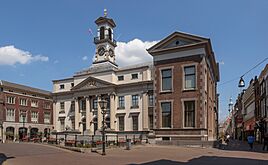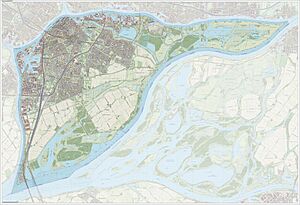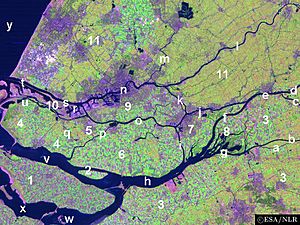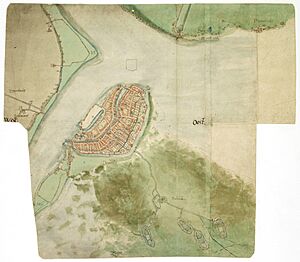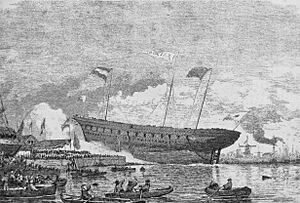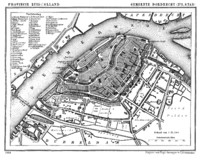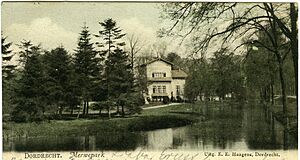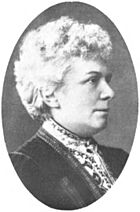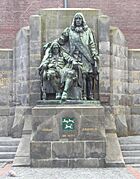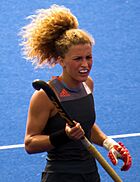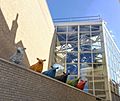Dordrecht facts for kids
Quick facts for kids
Dordrecht
Dordt
|
|||
|---|---|---|---|
|
City and municipality
|
|||
|
Augustijnenkamp
Historic city centre
Bleijenhoek
City hall
|
|||
|
|||
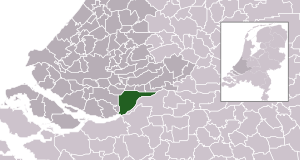
Location in South Holland
|
|||
| Country | Netherlands | ||
| Province | South Holland | ||
| City Hall | Dordrecht City Hall | ||
| Government | |||
| • Body | Municipal council | ||
| Area | |||
| • Municipality | 99.47 km2 (38.41 sq mi) | ||
| • Land | 79.01 km2 (30.51 sq mi) | ||
| • Water | 20.46 km2 (7.90 sq mi) | ||
| Elevation | 1 m (3 ft) | ||
| Population
(Municipality, May 2014; Urban and Metro, May 2014)
|
|||
| • Municipality | 118,782 | ||
| • Density | 1,503/km2 (3,890/sq mi) | ||
| • Urban | 237,848 | ||
| • Metro | 286,833 | ||
| Demonym(s) | Dordtenaar | ||
| Time zone | UTC+1 (CET) | ||
| • Summer (DST) | UTC+2 (CEST) | ||
| Postcode |
3300–3329
|
||
| Area code | 078 | ||
Dordrecht (pronounced like DOR-drecht), also known as Dordt, is a historic city and a municipality in the western Netherlands. It's located in the province of South Holland. Dordrecht is the fifth-largest city in its province, after Rotterdam, The Hague, Leiden, and Zoetermeer. It has a population of about 118,782.
The city covers the entire Dordrecht Island, often called Het Eiland van Dordt (the Island of Dordt). This island is surrounded by several rivers like the Oude Maas and Beneden Merwede. Dordrecht is the biggest city in the Drechtsteden area and is also part of the Randstad, which is a large group of cities in the Netherlands.
Dordrecht is the oldest city in the historical region of Holland. It has a very long and interesting history, along with a rich culture.
Contents
What's in a Name?
The name Dordrecht comes from old words like Thuredriht (around 1120). It seems to mean 'thoroughfare', which was a path or river where ships could be pulled from one river to another. This happened between the Dubbel and Merwede rivers.
The word 'drecht' might come from 'draeg', meaning 'to pull' or 'to drag'. People from Dordrecht are called Dordtenaren. Locals often call the city Dordt for short. In the past, when Dordrecht was a big trading port, it was also called Dort in English.
A Look Back in Time
How Dordrecht Began
The city grew up along the Thure river, which was part of a huge river system. This area was full of peat marshes. Around 1120, people first mentioned "Thuredrech" when talking about a historical event.
Dordrecht became a city in 1220, when it was given special "city rights" by William I, Count of Holland. This makes it the oldest city in the modern province of South Holland.
In the 12th and 13th centuries, Dordrecht became an important market city. This was because of its great location near rivers. It mainly traded in wine, wood, and cereals. In 1299, Dordrecht gained "staple right," which meant that goods passing through had to be offered for sale in the city first. This made it even more important.
In 1253, a Latin school was started in Dordrecht. It's still open today as the Johan de Witt Gymnasium. It is the oldest gymnasium (a type of secondary school) in the Netherlands.
On November 18–19, 1421, a huge flood called the Saint Elisabeth's flood hit southern Holland. This flood turned Dordrecht into an island. While old stories said over 10,000 people died, newer research suggests it was fewer than 200.
In 1457, a big fire destroyed many buildings in the city, including the Grote Kerk (Big Church).
The Union of Dordrecht
In 1572, during the Dutch Revolt against Spanish rule, something very important happened in Dordrecht. Representatives from almost all the cities of Holland met secretly. This meeting was called the Eerste Vrije Statenvergadering (First Assembly of the Free States), or the Unie van Dordrecht (Union of Dordrecht). It was a rebellious act because only the King of Spain or his representative could call such a meeting.
At this meeting, they talked about how to organize and pay for the fight against Spain. They officially rejected King Philip II of Spain. They also chose William of Orange as their leader and promised to support him financially. At William's request, they also declared freedom of religion for all of Holland.
This gathering is seen as the first big step towards the free and independent Dutch Republic. Other important meetings followed, leading to the official independence of the Dutch Republic in 1581.
The Union of Dordrecht meeting took place in an old Augustinian monastery, now called het Hof (the Court). The room where they met, de Statenzaal (The Hall of States), has a beautiful stained glass window showing the symbols of the twelve cities that were there.
The Synod of Dordrecht

From 1618 to 1619, a very important meeting of the Dutch Reformed Church happened in Dordrecht. It was called the Synod of Dordrecht. The synod aimed to solve big disagreements about religious ideas within the church. These disagreements were between the main ideas of Calvinism and a newer way of thinking called Arminianism.
This religious conflict had become a political problem, dividing society and almost causing a civil war in the young Dutch Republic.
Delegates from Dutch churches and Reformed churches in Germany, Switzerland, and England attended. The synod mainly focused on problems within the Dutch Reformed Church.
After much discussion, the synod decided that the ideas of the Arminians were against the church's teachings. They created the Canons of Dort, which explained the church's official beliefs. After the synod, many Arminian ministers lost their jobs, and some were even sent away from the country.
Less Economic Power
In the 18th century, Dordrecht's importance as a trading city started to decrease. Rotterdam grew to become the main city in the region.
Dordrecht was a big center for shipbuilding in the early 19th century. It was also important for the Dutch timber market. However, when the Nieuwe Waterweg canal opened in 1883, it made it much easier for ships to reach Rotterdam. This meant Dordrecht lost its position as a top sea harbor.
The traditional sugar refining industry in Dordrecht also struggled during the industrial revolution.
Dordrecht in Modern Times
Dordrecht has always been important for defending Holland. During World War II, when Germany invaded the Netherlands in 1940, German paratroopers landed in Dordrecht. There was fierce fighting, and many buildings in the city were destroyed. Towards the end of the war, Dordrecht was caught between the two armies. The city was finally freed by the Canadian Army.
In 1970, the nearby municipality of Dubbeldam joined Dordrecht. This made Dordrecht Island into one single municipality.
Parts of Dordrecht
Dordrecht is divided into 27 areas, including neighborhoods and small villages called hamlets:
- Binnenstad (city center)
- Reeland
- De Staart
- Oud-Krispijn
- Stadspolders
- Wielwijk
- Crabbehof, Zuidhoven
- Sterrenburg
- Dubbeldam (a former village)
- Kop van 't Land (hamlet)
- Tweede Tol (hamlet)
- Wieldrecht (hamlet)
- Willemsdorp (hamlet)
- Noordflank
- Nieuw-Krispijn
- Bleyenhoek
- Land van Valk
- Oudelandshoek
- Zeehavenlaan
- Lijnbaan
- Klein Dubbeldam
- De Hoven
- Zuidpolder
- Transvaalbuurt
- Indische buurt
- Vogelbuurt
- Van Gogh-buurt
People of Dordrecht
| Historical population | ||
|---|---|---|
| Year | Pop. | ±% p.a. |
| 1354 | 10,000 | — |
| 1398 | 7,500 | −0.65% |
| 1514 | 11,200 | +0.35% |
| 1555 | 10,000 | −0.28% |
| 1560 | 12,500 | +4.56% |
| 1622 | 18,270 | +0.61% |
| 1632 | 20,600 | +1.21% |
| 1665 | 20,000 | −0.09% |
| 1732 | 18,000 | −0.16% |
| 1795 | 18,014 | +0.00% |
In 2021, about 19% of Dordrecht's population had a non-Western background. Many of these people are young, while the Dutch population is getting older. Over six thousand Turks live in Dordrecht, many originally from Kayapınar.
Here's a look at the population groups in 2005 and 2008:
| Ethnic group | 01-01-2005 | 01-01-2008 |
|---|---|---|
| Native Dutch | 86,594 | 86,611 |
| Western foreigner | 11,610 | 11,580 |
| Turks | 6,113 | 6,326 |
| Moroccans | 2,521 | 2,611 |
| Surinamese | 2,759 | 2,796 |
| Netherlands Antilleans | 3,199 | 3,037 |
| Other non-Western foreigner | 6,528 | 5,226 |
| Total | 119,324 | 118,187 |
Culture and Fun
Dordrecht has a very rich culture because of its long history. The old city center has over 950 historic buildings. There are also 7 old churches and 6 museums. The city hosts many festivals and events every year.
Cool Places to See
- The Grote Kerk (Big Church) was built between 1285 and 1470. Its 65-meter tower has a carillon (a musical instrument with bells) with 67 bells. One of these bells weighs 9,830 kilos, making it the heaviest bell in the Netherlands!
- The Augustijnenkerk (Church of the Augustins) was built around 1293. It includes the Augustinian Monastery het Hof (the Court), where the First Assembly of the Free States took place.
- The Nieuwkerk (New Church) or St Nicolaas Kerk was built in 1175. Even though it's called "New Church," it's actually the oldest building in Dordrecht!
- The Munt van Holland (Mint of Holland) was a mint built in 1366. Most of the coins used in Holland during the Middle Ages were made here. Today, it's a music school.
- Kyck over den Dyck (View over the Dike) is the last windmill in Dordrecht. Built in 1612, it used to make malt for local beer brewers.
- The Groothoofdspoort (Big Head's Gate) is Dordrecht's original city gate. It was built in the 14th and 15th centuries. It stands where the rivers Meuse, Merwede, and Rhine meet.
- Arend Maartenshof (Arend Maarten's Court), built in 1625.
- Stadhuis city hall, built in 1383.
- Statue of Ary Scheffer (1861).
- Statue of Johan and Cornelis de Witt (1918).
- River quais (docks).
- Harbors.
- Old Merchant houses.
Museums to Explore
Dordrecht has several interesting museums:
- Binnenvaartmuseum: Learn about the history of boats that travel on inland waterways.
- Dordrechts Museum: Also called the "paintings museum." In summer, its garden hosts outdoor movie showings. It reopened in 2010 after a big makeover.
- Simon van Gijn museum: Named after a famous citizen, Simon van Gijn. It won a museum prize in 2004–2005.
- Museum 1940–1945: Also known as het Verzetsmuseum (the Resistance museum), it tells the story of World War II.
- Het Hof: This museum is about Dutch history.
- Onderwijsmuseum: Learn about the history of education and schools in the Netherlands.
Exciting Events and Festivals
Dordrecht hosts about 20 cultural and historical events each year. The city was even named "Best events city of the year" in 2003!
- Dordt in Stoom (Dordt in Steam) is one of the biggest steam events in Europe. You can see old steam trains and boats in action. It happens every two years and attracts many visitors.
- Kunstrondje Dordt (Little art circle Dordt) and Dordt Monumenteel (Dordt Monumental) focus on Dordrecht's art and architecture.
- Dordrecht has the second largest book market and the biggest Christmas market in the Netherlands.
- Wantijfestival is an outdoor music festival held every June since 1995. It takes place in Wantij park and draws thousands of people.
- Other popular music festivals include the World Jazz dagen (World Jazz days), Dancetour, Big Rivers Festival, and the Cello festival.
You can find a list of festivals on the Dordrecht Festivals website.
Fun Folklore
During Carnaval, Dordrecht is sometimes called Ooi- en Ramsgat (Ewe's and Ram's hole). Its people are known as Schapenkoppen (Sheepheads). This name comes from an old story: In the 17th century, there was a tax on meat or cattle brought into the city. To avoid paying, two men tried to sneak a sheep into the city by dressing it up like a person. But the sheep bleated as they passed through the gate, and they were caught! There's even a monument showing this funny legend. The local football team, FC Dordrecht, has a ram's head in its logo, and their fans sing about being "Dordtse sheep heads." There's also a special cookie called Schapenkop (sheep head).
A well-known saying about Dordrecht is Hoe dichter bij Dordt, hoe rotter het wordt (the closer to Dordrecht, the more rotten it gets). This might be because of the old "staple right," which meant traders had to stop in Dordrecht and offer their goods for sale. This could cause delays, and some products might spoil.
Nature Spots
East and south of Dordrecht is the Hollandse Biesbosch, part of the national park the Biesbosch. It's one of the largest national parks in the Netherlands and a rare freshwater tide area in Europe. The Dordtse Biesbosch has places for walking, rowing, and swimming.
There are also parks near the city, like Merwepark and Wantijpark.
Sports in Dordrecht
The Riwal Hoogwerkers Stadion is the home stadium for the local football team, FC Dordrecht. They play in the second national league.
The Dordts Dialect
Dordts is a special way of speaking Dutch that was traditionally used by the working class in Dordrecht. It's a type of Hollandic accent but also has sounds from other Dutch dialects.
Some unique things about Dordts include:
- Using -ie or -tie at the end of small words, instead of -je (e.g., appeltie instead of appeltje for "little apple").
- Borrowing words from other dialects.
- Pronouncing certain Dutch sounds differently.
Over time, fewer people speak the strong Dordts dialect, as more people use standard Dutch. You'll mostly hear the strongest Dordts dialect in the older working-class neighborhoods near the city center.
Economy and Jobs
Dordrecht's economy today relies on shipbuilding, the wood industry, and the steel industry. The city has the sixth largest sea port in the Netherlands. A big employer on Dordrecht Island is DuPont de Nemours (Nederland) B.V., which has several factories and employs many people.
New developments include "Learning" and "Health" Business Parks. The Learning Park will have lots of space for schools and colleges. The Health Park will offer many health services, with the Albert Schweitzer Hospital as its main point.
A new Sport Park is also being built near the Health Park. It will be a huge sports center with gyms, a skating rink, and a pool. Next to it, there will be a large outdoor area for events.
Shopping Fun
Shopping in Dordrecht's city center is mainly around the Voorstraat, Sarisgang, and Statenplein. The Voorstraat is 1,200 meters long, making it the longest shopping street in the Netherlands! Markets are held every Friday and Saturday on the Statenplein and in the Sarisgang.
Getting Around
Train Travel
Dordrecht is well connected to the Dutch train system and has international connections. There are three train stations in the city: Dordrecht railway station, Zuid railway station, and Stadspolders railway station.
There are four main train lines:
- South-West towards Roosendaal (including international trains to Belgium).
- South-East towards Breda and Eindhoven.
- North-West towards Rotterdam, The Hague, and Amsterdam.
- East towards Gorinchem and Geldermalsen.
You can find detailed information on the Nederlandse Spoorwegen (Dutch Railways) website: [1].
Bus and Waterbus
- Qbuzz is the city bus company for Dordrecht. It also runs trains to Gorinchem and Geldermalsen.
- The Waterbus is a fun way to travel by boat!
- Line 20 connects Dordrecht Merwekade to Rotterdam and other towns.
- Line 21 connects Dordrecht Hooikade to Zwijndrecht.
- Line 22 connects Dordrecht Merwekade to Papendrecht.
- Line 23 connects Dordrecht Merwekade to the Hollandse Biesbosch and Sliedrecht.
- Line 24 connects Dordrecht Merwekade to Zwijndrecht.
Famous People from Dordrecht
- See also People from Dordrecht
Artists and Writers
- Jacob Cats (1577–1660), a Dutch poet and lawyer.
- Aelbert Cuyp (1620–1691), a famous Dutch painter of landscapes.
- Nicolaes Maes (1634–1693), a Dutch painter of everyday scenes and portraits.
- Ary Scheffer (1795–1858), a Dutch-French Romantic painter.
- Cornélie van Zanten (1855–1946), a Dutch opera singer and teacher.
- Jan Veth (1864–1925), a Dutch painter, poet, and art critic.
- Kees Buddingh' (1918–1985), a Dutch poet and translator.
- Celinde Schoenmaker (born 1989), a Dutch theatre actress and singer.
- O'G3NE (formed 2007), a Dutch girl group who won The Voice of Holland.
Thinkers and Public Figures
- Jacob de Witt (1589–1674), a mayor of Dordrecht.
- Conrad Theodor van Deventer (1857–1915), a lawyer and writer about the Dutch East Indies.
- Pieter Geyl (1887–1966), a historian who studied Dutch history.
- Nicolaas Bloembergen (1920–2017), a Dutch-American physicist who won the 1981 Nobel Prize in Physics.
- Philip Scheltens (born 1957), a professor and expert on Alzheimer's disease.
Sports Stars
- Dirk Boest Gips (1864–1920), a Dutch sports shooter who won a bronze medal at the 1900 Summer Olympics.
- Hendrik de Iongh (1877–1962), a fencer who won a bronze medal at the 1912 Summer Olympics.
- Peter Smit (1961–2005), a Dutch martial artist.
- Marco Boogers (born 1967), a Dutch former professional football player.
- Danny Makkelie (born 1983), a Dutch FIFA football referee.
- Lucinda Brand (born 1989), a cyclist.
- Maria Verschoor (born 1994), a Dutch field hockey player who won a silver medal at the 2016 Summer Olympics.
- Jarno Opmeer (born 2000), a Dutch racing driver.
- Dilano van 't Hoff (2004-2023), a Dutch racing driver.
Images for kids
-
Windmill 'Kyck over den Dyck'
See Also
 In Spanish: Dordrecht para niños
In Spanish: Dordrecht para niños





